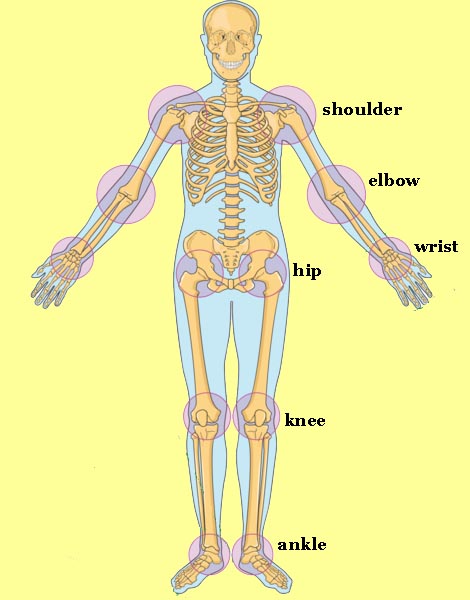 |
| The six big joints (Wikipedia) |
Note: Wrist, elbow, shoulder, hip, knee, ankle: most of these important joints have idioms to go with them, some of which you can learn in this lesson.
Get Ready: Move ("flex") each of the joints shown in the picture above. Which ones move differently? Which ones move in the same way?
Akemi asks Becky for help in the Common Room of their dorm.
--------Akemi: Hi, Becky. Our anatomy teacher wants us to learn the major joints in the body. Can you help me remember them?
Becky: Sure. Learning some idioms might help, too. Would that be all right?
Akemi: Great, thanks!
Becky: Where shall we start?
Akemi: How about the joint between the hand and the arm, where I wear my watch?
Becky: That's the wrist. You can remember, because the watch you're wearing is called a "wristwatch."
Akemi: Oh, yeah!
Becky: Also, there's an idiom. If we've done something well, and someone compliments us, we kind of brag by saying, "It's all in the wrist."
Akemi: Like a good tennis shot or something?
Becky: Good example! OK, next, in the middle of the arm is the elbow.
Akemi: Oh, tennis again; I think there's a kind of injury to that joint that's called "tennis elbow."
Becky: Right. We also talk about "elbowing your way into a crowd": using your elbows to poke people to get out of your way.
Akemi: Got it. Next, where the arm meets the body, is the soldier?
Becky: Not "soldier," Akemi, "shoulder."
Akemi: Sorry.
Becky: That's OK. It's an easy mistake. Here's an idiom: we can talk about "shouldering a burden."
Akemi: Or, I can thank you for being my "shoulder to cry on"?
Becky: True, and also for not ignoring you, or giving you "the cold shoulder."
Akemi: Haha! OK, so that's the arm. What about the leg?
Becky: Again, starting farthest from the main part of the body, where the foot meets the leg is called the ankle.
Akemi: OK. How can I remember that?
Becky: The only thing I can think of is, there's a pretty piece of jewelry you can wear called an "ankle bracelet."
Akemi: No idioms?
Becky: Not really, no.
Akemi: What's next?
Becky: Mid-leg is the knee.
Akemi: OK.
Becky: Lots of idioms for this one: when you're overwhelmed by something you can say you're "knee-deep" in it; or sometimes we talk about going "down on your knees" to pray.
Akemi: I think I get it. And last is the hip?
Becky: That's right. It's where the leg meets the body. We often talk of the hips and the shoulders as pairs: "Put a sweater around your shoulders" or "wear your pants low on your hips."
Akemi: Any hip idioms?
Becky: Sure. We say a person who is very direct "shoots from the hip," like a cowboy who's good with his gun; and when a couple of friends are very close we say they're "joined at the hip."
Akemi: Like so-called "Siamese twins"?
Becky: Exactly. You got it now?
Akemi: I think so. Thanks for your help, Becky.
Becky: No problem!
Read more: https://en.wikipedia.org/wiki/Joint
Practice: Match the term to its definition below:
- anatomy
- ankle bracelet
- brag
- down on your knees
- elbowing your way into a crowd
- giving someone the cold shoulder
- hips
- It's all in the wrist.
- joined at the hip
- knee-deep in something
- shoots from the hip
- shoulder to cry on
- shouldering a burden
- tennis elbow
- tell someone you're very good at something
- an injury to a certain joint
- a way to brag after doing something well
- carrying a load, physical or mental
- someone who listens to our problems
- is very direct
- describes friends who are very close
- deeply involved in something
- the science that studies the body and its parts
- praying to God
- poking people to get them out of your way
- like the shoulders, usually discussed in pairs
- jewelry worn above the foot
- ignoring someone
Answers are in the first comment below.
Submitted to the Shenzhen Daily for February 23, 2012
This lesson received 186 visits on my old site between February, 2012, and July, 2021.


Answers to the Practice: 1. i; 2. m; 3. a; 4. j; 5. k; 6. n; 7. l; 8. c; 9. g; 10. h; 11. f; 12. e; 13. d; 14. b
ReplyDelete